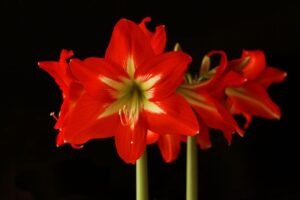In this guide, we’ll explore a variety of climbing plants that thrive in full sun conditions, from the classic clematis to the vibrant bougainvillea. So grab your gardening gloves and let’s get started on this exciting journey through the world of climbing plants!
Clematis (Clematis spp.)
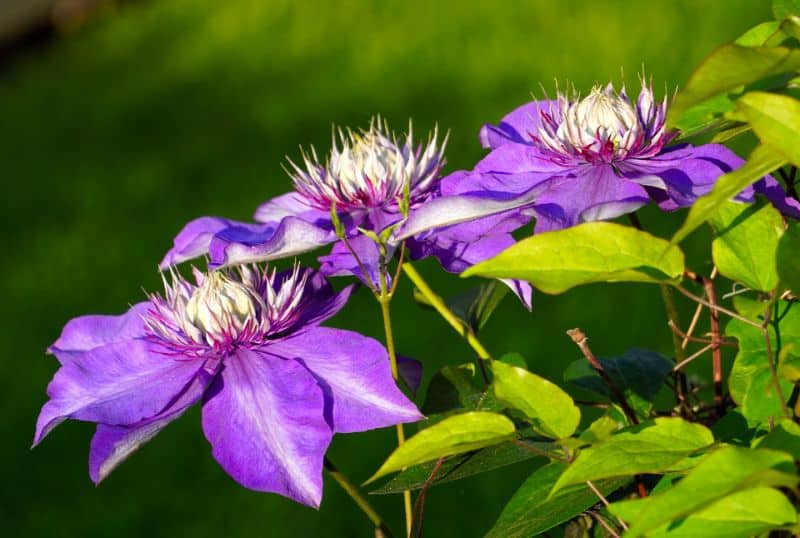
Clematis is a diverse genus that includes more than 300 species, ranging from herbaceous perennials to woody vines. The beauty of clematis lies not only in its stunning flowers but also in its long blooming season, offering an array of colors and forms. Full sun is often preferred by many clematis varieties, especially the large-flowered hybrids, which develop abundant blooms in good sunlight.
When choosing clematis for your garden, consider the variety’s growth habit and flowering time. Some varieties, like ‘Jackmanii’, offer large, rich purple flowers, while ‘Nelly Moser’ features pink stripes that dance across soft white petals. These climbing plants can reach heights of 6 to 15 feet, and their climbing mechanism relies on leaf petioles that wrap around supports, making them excellent for wrapping around trellises or fences.
An important tip for cultivating clematis is to ensure that their roots remain cool, while their tops bask in the sun. Mulching the base with stones or planting companion plants can help keep the soil temperature down. Clematis not only provides a gorgeous display but also creates a backdrop for other flowers, making it a dynamic choice in full sun vertical gardening.
Climbing Hydrangea (Hydrangea anomala ssp. petiolaris)
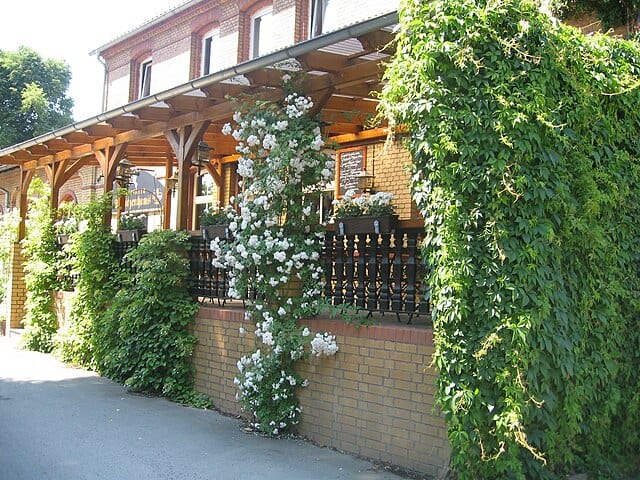
Climbing hydrangea delights gardeners with its elegant appearance and capability to thrive in various conditions, though it prefers some sun. This low-maintenance climber boasts glossy green leaves that create a lush green wall, while its white lace-cap flowers provide a soft, romantic touch in summer.
The unique characteristic of climbing hydrangea is its ability to cling to surfaces with aerial roots, making it a great option for brick walls or wooden structures. This vine can reach heights of 30 feet when adequately supported, often growing slowly at first but eventually covering a significant area.
One of the key benefits of climbing hydrangeas is their adaptability; they can thrive in both full sun and partial shade, which makes them versatile in diverse landscapes. That said, planting them in full sun will typically result in the best blooming performance. Additionally, climbing hydrangeas are quite drought-tolerant once established, making them an excellent choice for sustainable gardening.
Chocolate Vine (Akebia quinata)
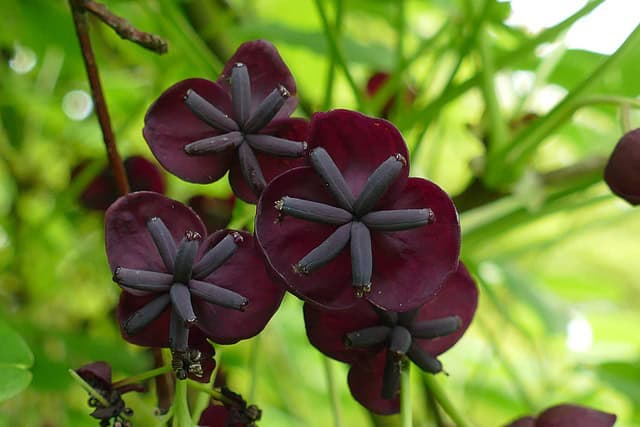
If you’re looking for an unusual vine with a delightful scent and tasty fruit, consider introducing the chocolate vine into your full sun garden. With its striking dark purple flowers that resemble little bells, this fast-growing vine is a showstopper. The flowers begin blooming in early spring, filling the air with a sweet, chocolate-like fragrance that attracts pollinators.
Apart from aesthetic appeal, the chocolate vine has the added benefit of producing edible fruits known as “five-flavor fruits” due to their unique taste profile. These fruits are ripened when they turn a golden color and are often used in desserts and soups.
With vigorous growth, the chocolate vine can reach heights of 30 feet and requires sturdy support systems like pergolas or fences. It’s also relatively low-maintenance, given it thrives in full sun and can tolerate drought conditions once established. However, prune it back after flowering to control its size and promote better airflow, which helps minimize disease risks.
Hardy Kiwi Vine (Actinidia arguta or Actinidia kolomikta)
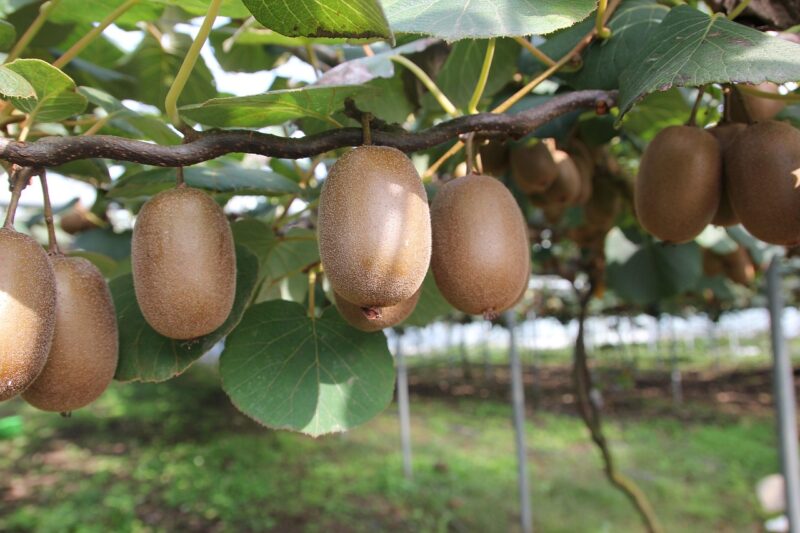
The hardy kiwi vine is a fantastic option for gardeners hoping to grow something unique and delicious. Unlike the larger, fuzzier kiwis you find in grocery stores, hardy kiwis boast smooth skin and tiny seeds, making them edible without peeling. They are also sweet and rich in vitamins and antioxidants, and the plants thrive in full sun locations.
These climbing vines can reach up to 20 feet and will need sturdy trellises for support. Hardy kiwi vines are typically dioecious, meaning they have separate male and female plants; thus, you will need at least one male plant to pollinate female plants for fruit production.
In addition to their fruit, these hardy vines produce attractive foliage, particularly the variegated varieties like ‘Kolomikta’, which showcases stunning pink and white leaf margins. They usually have a vigorous growth pattern, so regular pruning is advisable to keep them manageable and ensure a steady flow of fruit. Hardy kiwi vines are an exciting addition to any full sun garden due to their aesthetic value and edible yield.
Purple Passionflower (Passiflora incarnata)

The purple passionflower, known for its exotic, intricate blooms, is a captivating addition to full sun gardens. This perennial vine can climb over fences and arbors, achieving heights of 10 to 20 feet. The striking flowers attract butterflies, hummingbirds, and bees, enhancing the biodiversity of your garden.
One of the thrilling aspects of Passiflora incarnata is its fast growth rate and the unique shape of its flowers, which feature a prominent corona of filaments surrounding a central pistil and stamens. The bloom period occurs from late spring to early fall, offering continuous color during the warmer months. Furthermore, if pollinated, the flowers can produce edible fruit, commonly known as the maypop.
Cultivating the purple passionflower is relatively easy; it thrives in well-drained soil and prefers full sun. However, it can also tolerate partial shade, making it adaptable to various garden settings. Be aware that purple passionflower can become invasive in certain areas, so keeping an eye on its growth and managing its spread is crucial.
Trumpet Vine (Campsis radicans)
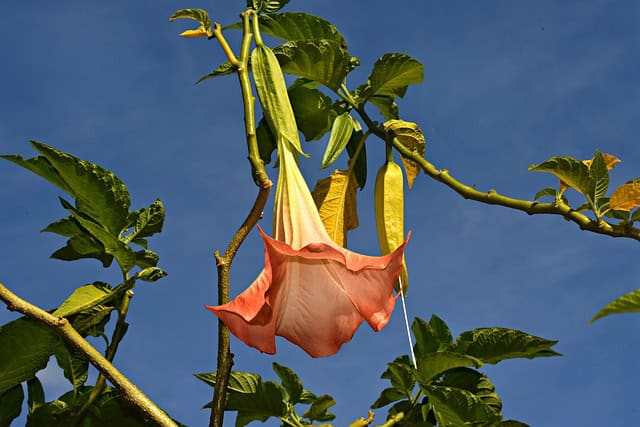
Looking to add a dramatic flair to your garden? The trumpet vine could be your perfect match. With vibrant, trumpet-shaped flowers that bloom from late spring to fall, these climbing plants are sure to grab attention. Their bright orange to red flowers attract hummingbirds and butterflies, making your garden a lively haven for pollinators.
This vigorous vine can grow up to 30 feet, rapidly covering trellises, fences, and arboretums. Despite its beauty, trumpet vine can become invasive, so it’s crucial to plant it in a spot where its growth can be controlled. Regular pruning in the late winter or early spring allows you to manage its size and encourage blooming.
While the trumpet vine thrives in full sun, it can also tolerate a variety of conditions, including drought and poor soil. To maximize flowering, ensure adequate sunlight, and provide support systems for climbing. This incredible vine offers not just spectacular color but also wildlife support, all while being relatively low-maintenance.
Climbing Roses (Rosa spp.)
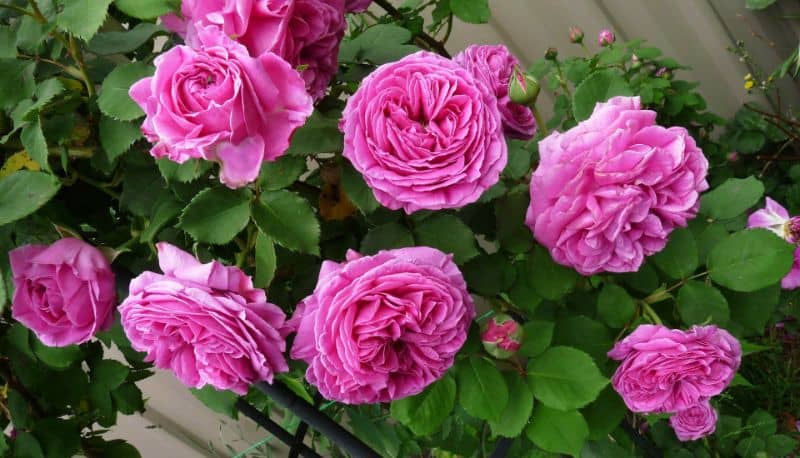
A timeless classic, climbing roses are a staple in many gardens, bringing charm and elegance with their rich fragrance and gorgeous blooms. This diverse group includes various species and hybrids, each presenting unique flowers that vary in color, shape, and fragrance, ensuring there’s a climbing rose for every garden style.
Climbing roses can reach heights of 8 to 20 feet, thriving in sunny spots with well-drained soil. These plants rely on support structures, such as trellises or garden arches, to showcase their full potential. It’s essential to train them appropriately during their early growth stages to encourage upward growth and maximize their visual impact.
Regular pruning is necessary to promote airflow, maintain size, and encourage repeat blooming. By removing dead or weak stems, you’re enhancing sunlight penetration to the interior of the plant, ultimately leading to healthier blooms. By incorporating climbing roses into your vertical garden, you’ll create an enchanting vertical display filled with color and fragrance throughout the growing season.
Star Jasmine (Trachelospermum jasminoides)
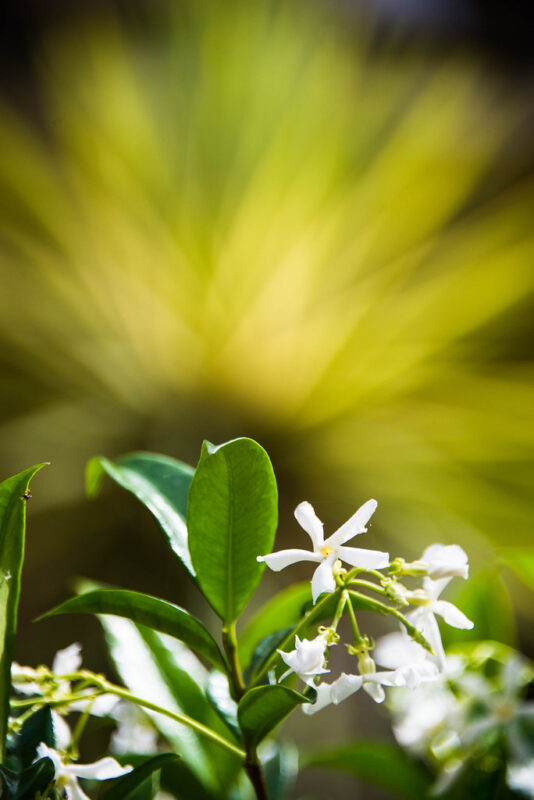
Star jasmine, known for its delightful scent and glossy leaves, adds a sophisticated flair to full sun gardens. As a hardy evergreen vine, this plant can climb up to 20 feet, making it an ideal choice for covering walls, fences, or trellises. In the spring and early summer, it erupts into clusters of small white star-shaped flowers that exude a sweet fragrance, attracting pollinators and creating an inviting ambiance.
This climber is adaptable to various soil types and can thrive in full sun or partial shade, although the best flowering results occur in well-lighted areas. Pruning is essential to keep the vine in check, especially if it’s growing unchecked, which can lead to leggy growth and reduced flowering.
One fascinating aspect of star jasmine is its ability to thrive in varying climates, making it a versatile choice for gardeners across regions. It’s also relatively drought-tolerant once established, contributing to a sustainable gardening approach. With its combination of visual appeal and aromatic presence, star jasmine can enhance the overall aesthetics of any sunny garden.
Mandevilla (Mandevilla spp.)
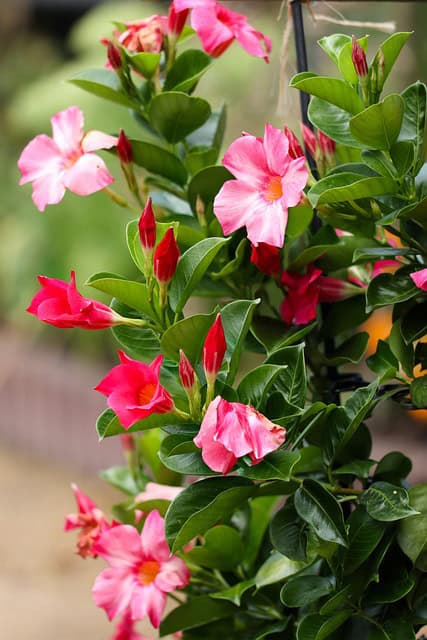
Mandevilla vines are celebrated for their lush, tropical appearance and vibrant blooms. These climbers can grow up to 10 feet or more, offering an explosion of color with their trumpet-shaped flowers. Available in shades of pink, red, and yellow, mandevilla creates a vivid display during the summer months while also drawing in hummingbirds and butterflies.
These plants thrive in full sun environments and prefer well-drained soil. Mandevilla vines require support, and they can effectively climb on fences, trellises, or arbors, creating stunning vertical landscapes. Interestingly, mandevilla is considered a tender perennial in many regions, and it can be grown as an annual in cooler climates or brought indoors during colder months.
Regular watering and fertilization during the growing season encourage vigorous growth and prolific blooming. Pruning is also beneficial; removing dead or damaged stems encourages healthier growth of new flowers. With their stunning blooms and tropical feel, mandevilla vines can transport your garden to a vacation vibe, even if you’re just in your backyard.
Bougainvillea (Bougainvillea spp.)
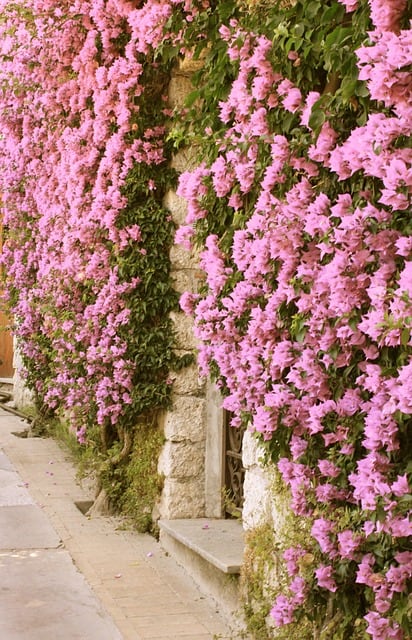
Bougainvillea is often referred to as the “queen of climbers,” and for a good reason. Its vibrant bracts come in various colors—magenta, purple, orange, and white—creating a dazzling display that adds joy and vibrancy to any garden. These hardy vines can thrive in full sun and are well-suited for hot, dry climates, making them ideal for gardens that may struggle with other plants.
Bougainvillea can grow rapidly, reaching heights of up to 30 feet, but they require sturdy support structures for climbing. Whether adorning fences, garden walls, or trellises, their cascading blooms make for a breathtaking sight. One unique aspect of bougainvillea is its drought tolerance; once established, it can thrive with minimal watering.
However, they do benefit from some pruning to maintain shape and promote blooming. Bougainvilleas tend to bloom best when slightly stressed, so be careful not to overly fertilize them. With their rich colors and resilience, bougainvilleas can create an enchanting atmosphere in your full sun garden.
Moonflower (Ipomoea alba)
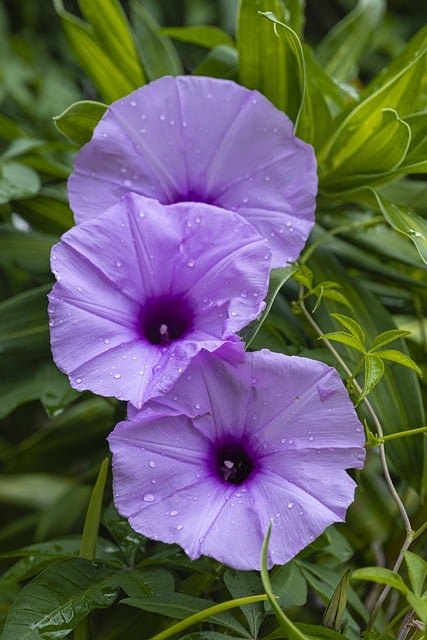
For a truly captivating addition to your nighttime garden, look no further than the moonflower. Known for its enchanting white blooms that open just as dusk settles, this vine attracts nighttime pollinators like moths and adds an air of romance to your garden after dark. Moonflowers can grow rapidly, reaching lengths of 10 to 15 feet, and they thrive in full sun conditions during the day.
To encourage healthy growth, provide ample support, as moonflowers gracefully twine their way up trellises and fences. The large, heart-shaped leaves create a lush green backdrop, allowing the striking white flowers to stand out against the foliage.
Another fantastic aspect of moonflowers is their fragrance, which intensifies during the evening. When planting moonflower, ensure it has enough space and is in well-drained soil to avoid waterlogging. If you’re seeking a climbing plant that offers beauty both day and night, the moonflower is a sublime choice.
Cape Honeysuckle (Tecoma capensis)

Cape honeysuckle is a stunning evergreen vine that boasts clusters of tubular orange and yellow flowers, attracting hummingbirds and butterflies to your garden. This fast-growing plant can reach heights of up to 30 feet, making it an eye-catching addition to vertical gardening.
Though it thrives in full sun, cape honeysuckle can tolerate some partial shade, providing flexibility for different gardening situations. It’s an excellent choice for covering fences, walls, and arbor structures, ensuring a vibrant display throughout the growing season. However, regular pruning is necessary to keep it in check and maintain its bushy appearance.
Cape honeysuckle is relatively drought-tolerant once established, making it a sustainable option for gardens aiming for water conservation. Its hardy nature and ability to attract wildlife make it not only visually appealing but also beneficial for the ecosystem. Incorporating this climber adds both charm and vibrancy to your full sun landscape.
Japanese Honeysuckle (Lonicera japonica)
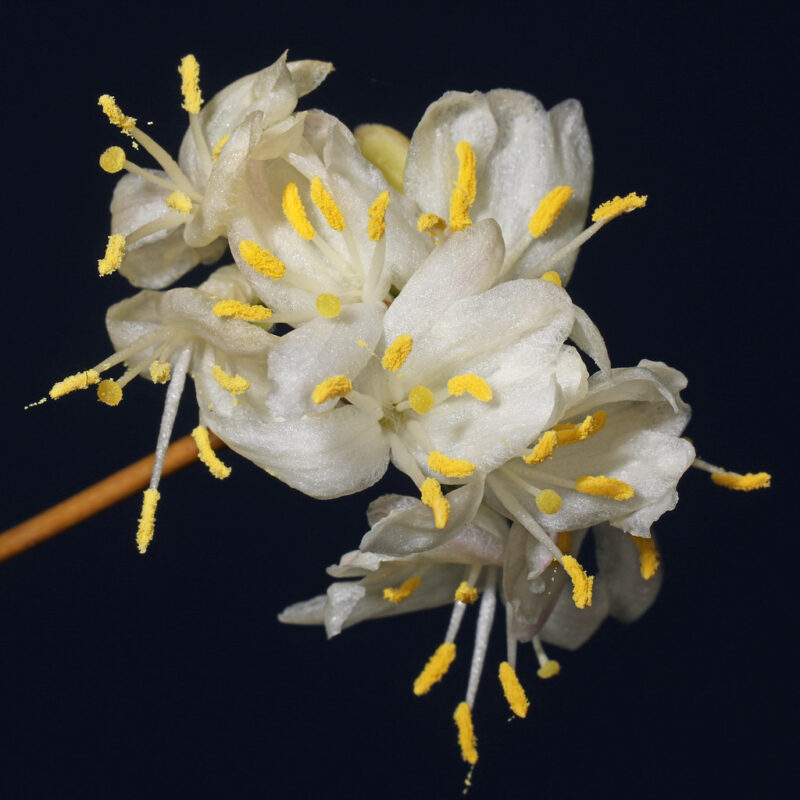
Japanese honeysuckle is a popular climber known for its fragrant flowers and sweet nectar. This woody vine can grow quickly in full sun, reaching heights of 20–30 feet and often covering trellises and fences with ease. It produces clusters of tubular flowers in creamy white and yellow shades, blooming throughout the warmer months.
While it’s loved for its intoxicating fragrance and ability to attract pollinators, it’s important to note that Japanese honeysuckle can become invasive in some regions, so careful management is essential. Control its growth by regular pruning and ensuring that it doesn’t overtake other beloved garden plants.
Though it thrives in full sun, Japanese honeysuckle can tolerate partial shade, making it adaptable to various garden settings. Its lush foliage and fragrant blooms provide a sensory experience, making this vine an appealing option for full sun areas while providing a beautiful and aromatic backdrop for gardens.
Black-Eyed Susan Vine (Thunbergia alata)
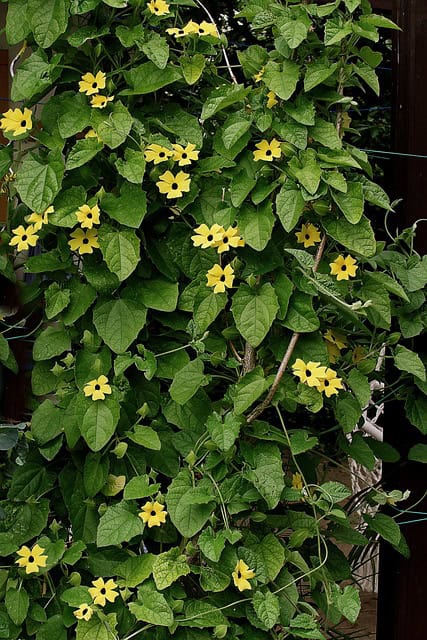
The black-eyed Susan vine is a delightful climbing plant known for its cheerful, sunflower-like blooms. These annual vines typically grow between 5 to 10 feet and thrive in full sun, creating a vibrant display in gardens and containers alike. The flowers, available in shades of yellow, orange, and white, are often adorned with a dark center that resembles a black eye, hence the moniker.
This vine is incredibly easy to grow; provide a trellis or support system, and it will quickly cover any area with its exuberant blooms. In addition to its visual appeal, the black-eyed Susan vine attracts butterflies and hummingbirds, making it a great option for those aiming to enhance garden biodiversity.
Regular watering and feeding throughout the growing season will ensure abundant blooms. Since it’s an annual in most regions, consider replanting each year for continuous enjoyment. The black-eyed Susan vine effortlessly brings color and cheer to full sun gardens, enhancing vertical spaces and creating a lively atmosphere.
Cup and Saucer Vine (Cobaea scandens)

The cup and saucer vine is named for its unique, bell-shaped flowers that bloom in shades of purple and green, resembling a cup resting on a saucer. This fast-growing vine can easily reach heights of 10 to 15 feet and prefers full sun to flourish. Providing a strong support structure will allow it to climb and showcase its eye-catching blooms effectively.
This vine can be a bit more challenging to grow, as it may require staking as it climbs due to its weight. However, with proper care and attention, cup and saucer vines will generously reward you with their captivating appearance and impressive growth.
These climbing plants prefer fertile, well-drained soil and consistent watering. Regular pruning will promote better airflow and healthier growth, especially as it matures. If you’re seeking a unique and striking feature for your full sun garden, the cup and saucer vine is an ideal candidate.
Bleeding Heart Vine (Clerodendrum thomsoniae)
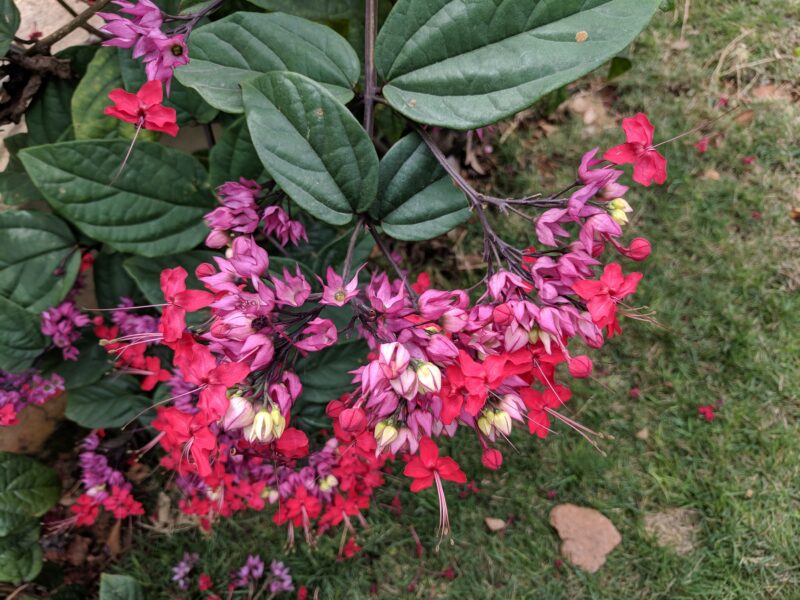
The bleeding heart vine, with its striking heart-shaped flowers, offers a unique twist to the climbing plant selection for full sun gardens. This tropical beauty produces clusters of red flowers that dangle like delicate hearts, surrounded by lush green leaves, creating a stunning visual effect.
Bleeding heart vines can rapidly grow up to 10-15 feet and can adapt to various growing conditions, though they thrive best in full sun or partial shade with regular watering. They are especially appealing for arbors, trellises, or fences, where their vibrant blooms can be most appreciated.
While generally easy to care for, it’s essential to prune this vine after flowering to encourage robust growth for future blooms. If you desire a captivating and romantic atmosphere in your garden, the bleeding heart vine can infuse your space with beauty and charm.
Corkscrew Vine (Cochliasanthus caracalla)

The corkscrew vine is certainly one of the most intriguing climbing plants available for gardeners. With twirling, spiraling flower clusters that produce a sweet fragrance, this unique vine can be a conversation starter. The flowers, which bloom from spring to fall, are often cream or pale yellow and can reach a height of 10 to 15 feet.
The corkscrew vine grows best in full sun, preferring moist, well-draining soil. It requires sturdy support as it climbs, and with the appropriate care, it can quickly cover structures and create an eye-catching display.
Regular watering and occasional feeding will encourage healthy growth and plentiful blooms. The corkscrew vine’s unique blossom structure catches the eye and adds an element of whimsy to gardens. If you seek a climbing plant that’s both functional and fascinating, the corkscrew vine is an excellent option for creating a magical garden atmosphere.
Sweet Potato Vine (Ipomoea batatas)
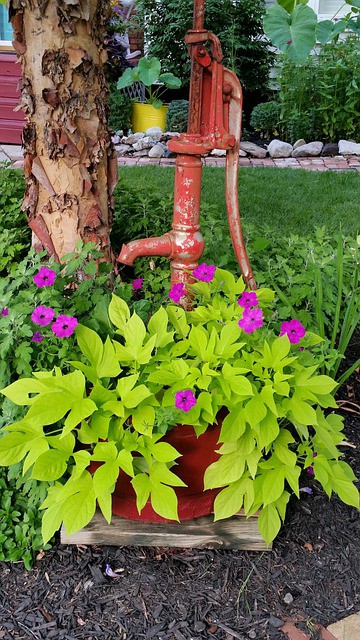
Sweet potato vine is beloved not just for its edible qualities but also for its vibrant foliage that comes in various colors, including vibrant green, lime, and deep purple. This versatile vine thrives in full sun and can quickly spread and cover garden areas, reaching heights of 10 feet or more.
The lush foliage creates a beautiful backdrop for garden displays, and as an added benefit, the sweet potato vines produce edible tubers if desired. These vines also work well as container plants, cascading over pots and providing a colorful touch to patios and balconies.
It’s important to keep them well-watered, especially during hot spells, to maximize their growing potential. Pruning will help control their spread and maintain their appearance. The sweet potato vine’s aesthetic appeal and culinary potential make it a delightful addition to full sun gardens.
Snapdragon Vine (Maurandya scandens)
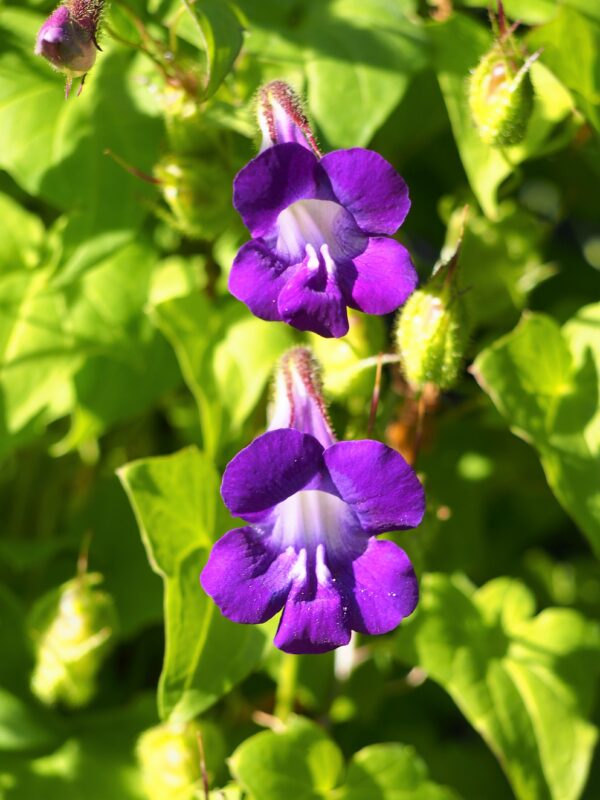
Snapdragon vine is an enchanting climber that offers a continuous display of delicate, snapdragon-like flowers in various colors, including shades of white, pink, purple, and blue. This annual vine can grow to heights of about 6 to 8 feet, making it perfect for trellises and supports in sunny garden areas.
With a preference for full sun, the snapdragon vine thrives with consistent moisture and well-drained soil. This fast-growing vine is relatively low-maintenance and can quickly add charm to any vertical gardening space. Regular deadheading will encourage new blooms, allowing for an extended flowering period from summer to fall.
Moreover, this vine is a magnet for pollinators, including bees and butterflies, making it a beneficial addition to any garden. If you want an easy-to-grow and visually appealing climbing plant that thrives in full sun, the snapdragon vine is the perfect solution.



